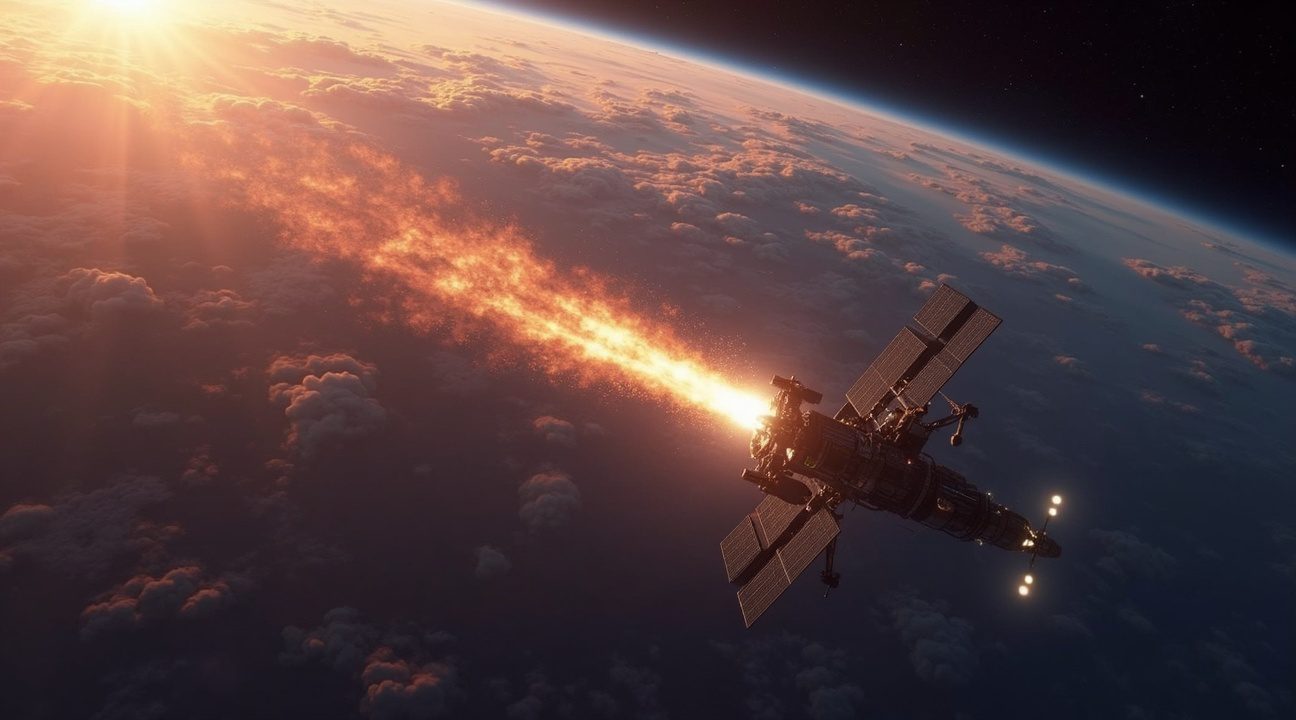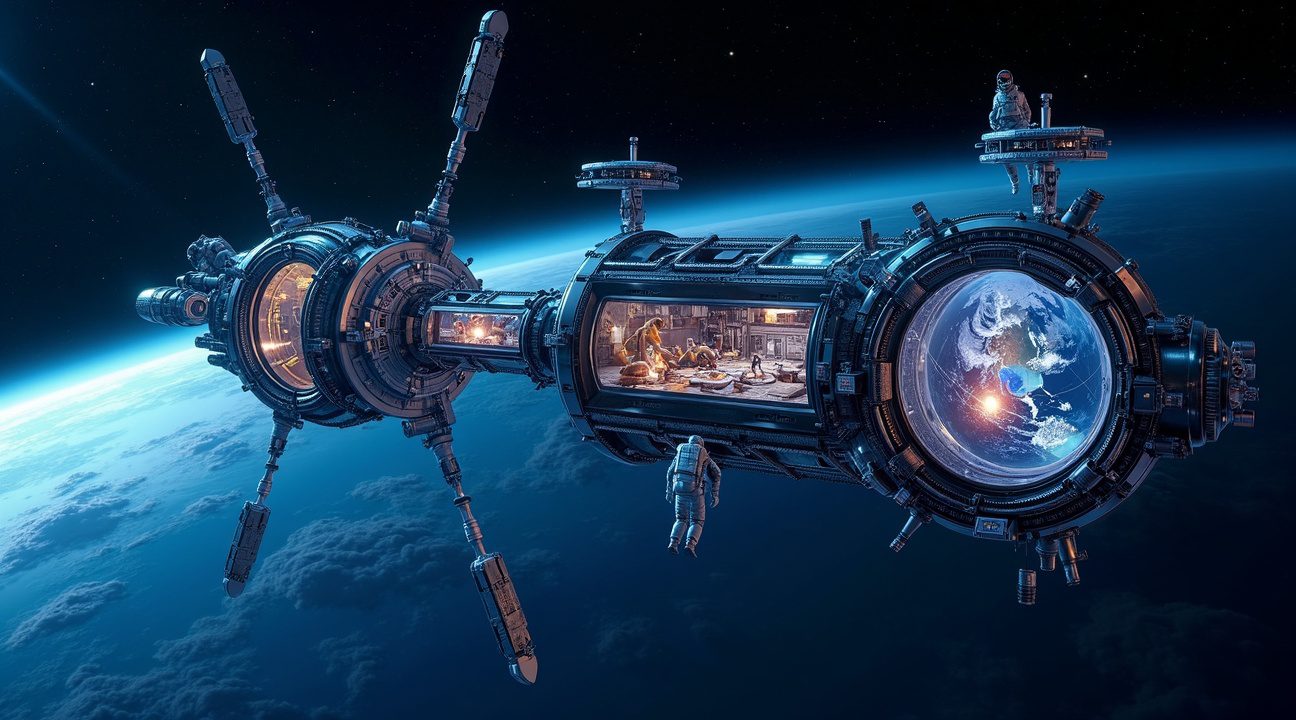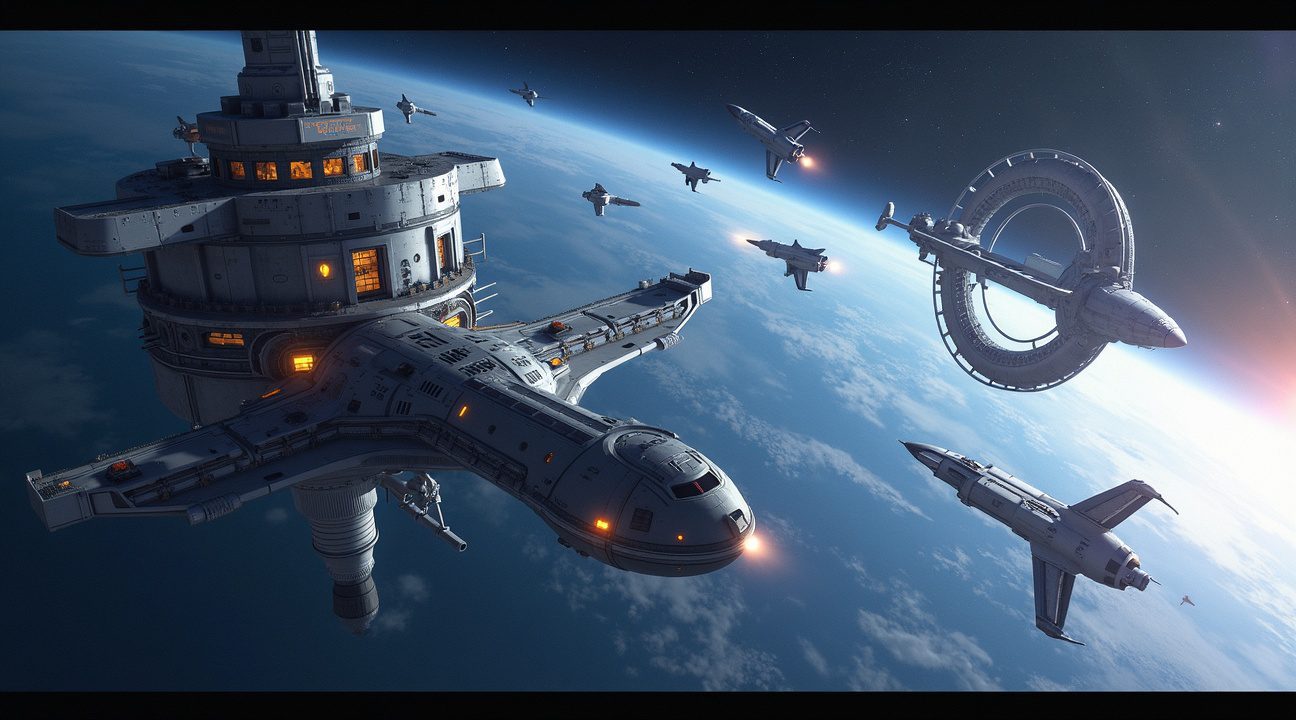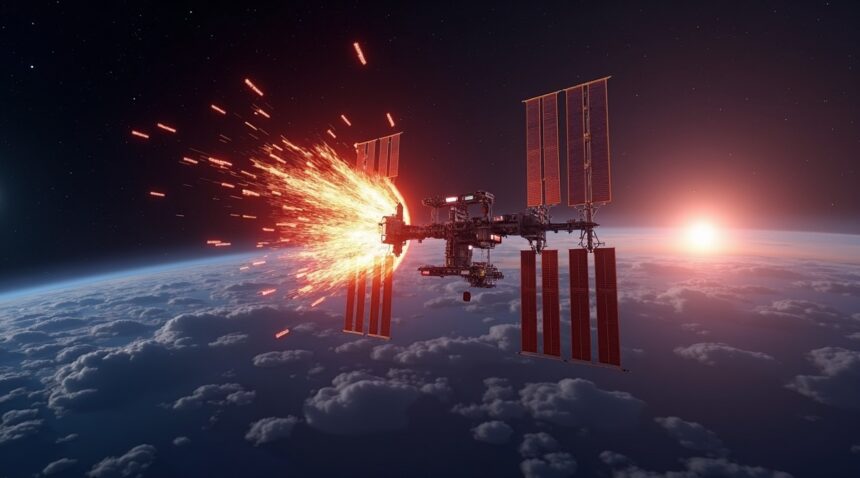NASA has awarded SpaceX an $843 million contract to develop a specialized deorbit vehicle that will facilitate the controlled destruction of the International Space Station in 2030, marking the end of a 32-year era of groundbreaking science and international collaboration in low-Earth orbit.
Key Takeaways
- SpaceX will build a U.S. Deorbit Vehicle designed to safely guide the ISS through a planned atmospheric re-entry over a remote Pacific Ocean location, ensuring the station breaks apart entirely during descent.
- The ISS will retire in 2030 as its aging infrastructure, including critical systems like radiators and core modules, poses safety and mission effectiveness concerns.
- Over 4,000 scientific experiments have been conducted on the ISS, generating more than 4,400 peer-reviewed studies, with breakthroughs in DNA sequencing, cancer research, and artificial retina development.
- NASA has invested over $400 million in five commercial companies — Axiom Space, Blue Origin, Northrop Grumman, Starlab, and Vast — to develop next-generation orbital stations.
- The ISS serves as a model for international cooperation in space, helping shape future plans for the Moon, Mars, and other long-term missions through shared resources and expertise.
SpaceX’s Track Record and Mission Role
SpaceX secured this high-value NASA contract due to its consistent and successful track record with International Space Station operations, ranging from cargo resupply to crewed missions. The company’s expertise played a critical role in establishing its capability to execute this complex and high-risk deorbit operation.
The deorbit vehicle will be a new spacecraft engineered specifically for the challenges of bringing down the ISS, which is the size of a football field and weighs around 925,000 pounds. It will dock onto the ISS’s forward port and provide the propulsion needed for its controlled descent, adhering to established re-entry protocols to minimize risks to populated areas.
Why 2030 Marks the ISS’s Closure
The station’s aging components — some dating back to its 1998 launch — are showing wear across essential systems such as thermal control, life support, and structural integrity. Although regular maintenance has extended functionality, many components now run beyond their initial design life, prompting NASA to set the 2030 timeline for safe retirement.
Unprecedented Scientific Impact
The ISS has proved priceless for scientific discovery. The station enabled unique studies not possible on Earth due to microgravity, such as protein crystal growth, which supports pharmaceutical research. Experiments have led to improved drug therapies, better understanding of human body changes in space, and the development of high-precision medical tools.
Cancer Research in Space
Microgravity allows researchers to grow larger and more uniform protein crystals, teasing out mechanisms that help design more effective cancer drugs. NASA collaborates with pharmaceutical firms to leverage these conditions, pushing the boundaries of Earth-bound medical treatment through space-enabled science.
The Future of Low-Earth Orbit: Commercial Space Stations
NASA’s Commercial LEO Destinations program promotes the development of privately operated space stations to continue serving scientific and commercial needs in space after ISS retirement.
- Axiom Space: Plans a modular, expandable station initially connected to the ISS, focusing on manufacturing and advanced R&D.
- Blue Origin & Sierra Space: Collaborating on Orbital Reef, a mixed-use orbital business park.
- Starlab: Emphasizes automation and streamlined crew requirements to lower operating costs.
- Vast: Innovates with artificial gravity by rotating station modules, a potential game-changer in long-duration space travel.
Model of International Collaboration
The ISS remains a symbol of global unity in space, with contributions from NASA, Roscosmos, ESA, JAXA, and CSA. Despite geopolitical tensions, this collaboration has withstood the test of time and continues to shape international strategies for upcoming missions under initiatives like the Artemis lunar program and eventual Mars exploration.
Technical Challenges Ahead for SpaceX
The deorbit mission involves major engineering feats — from designing fuel systems capable of executing complex orbital maneuvers to ensuring redundancy for high-risk phases of descent. SpaceX’s experience with reusable spacecraft and autonomous docking systems offers a strong foundation, but this mission will demand customized hardware and mission protocols.
Maximizing the ISS’s Final Years
Between now and 2030, NASA and international partners plan to squeeze every ounce of scientific value from the ISS. Focus will shift to critical experiments that cannot yet transition to commercial platforms. Careful planning ensures research continuity even as operations wind down.
The Tradeoff: Capabilities vs. Cost
Early commercial space stations will have more limited crew capacities and infrastructure than the ISS. However, competition and private funding often accelerate innovation. Additionally, having multiple orbiting labs mitigates risks associated with relying on a single platform and reduces the overall cost burden on public agencies.
Financial Rationale Behind the Deorbit Contract
The $843 million cost of the deorbit vehicle is a sound investment considering the risks and costs of an uncontrolled reentry. A controlled descent mitigates the threat of debris and reduces insurance liabilities, making this contract both a technical and fiscal necessity.
Legacy of the ISS
The impact of the ISS will extend far beyond its physical existence. NASA is codifying operational know-how, maintenance strategies, and long-duration crew practices for future use. These insights are already shaping the architecture of commercial stations.
Scientific data collected aboard the station continues to produce discoveries, as samples undergo extended analysis on Earth. The full value of the ISS program will emerge over years, with unfolding developments across medicine, materials science, and space systems engineering.
Meeting the 2030 Deadline
SpaceX must finalize development of the deorbit craft — from prototype testing to operational certification — by the 2030 deadline. Its previous work with reliable spacecraft like the Crew and Cargo Dragon will support this aggressive timeline. Frequent milestone check-ins and NASA oversight will ensure the program remains aligned with mission objectives.
A New Era of Space Exploration
The ISS retirement represents both a conclusion and a gateway. After 32 years of uninterrupted operation, it has proven the value of space stations in driving science and fostering unity. As commercial platforms rise and exploration extends beyond Earth’s orbit, the ISS’s legacy will continue — through data, engineering standards, international collaboration, and the next generation of orbital laboratories.
SpaceX Wins $843 Million Contract to Destroy the Space Station in 2030
NASA has awarded SpaceX an impressive $843 million contract to develop the U.S. Deorbit Vehicle that will bring down the International Space Station in a controlled manner. This specialized spacecraft will attach to the ISS and guide it through a carefully planned re-entry into Earth’s atmosphere, marking the end of one of humanity’s greatest collaborative achievements in space.
The deorbit vehicle will target a remote region of the Pacific Ocean for the station’s final descent. Both the vehicle and the ISS are expected to break apart completely during re-entry, ensuring that no large debris pieces survive to potentially threaten populated areas on Earth. This approach represents the safest method to conclude the station’s operational life after decades of service.
Why Other Decommissioning Options Didn’t Make the Cut
NASA carefully examined several alternatives before settling on controlled destruction. Engineers considered disassembling the station piece by piece in space, similar to how it was originally constructed. They also evaluated boosting the ISS to a higher orbit where it could remain indefinitely as a space monument.
However, these alternatives presented significant challenges that made them impractical. The station’s enormous size—comparable to a football field—creates logistical nightmares for any disassembly operation. Current infrastructure limitations in space also lack the capability to safely manage such a complex undertaking. Safety concerns further complicated these options, as partial disassembly could create dangerous debris fields that might threaten other spacecraft or future missions.
The Technical Challenge Ahead
SpaceX faces a complex engineering challenge in developing the deorbit vehicle. The spacecraft must be powerful enough to safely guide the massive station through its final journey while maintaining precise control throughout the descent process. This mission builds on SpaceX’s extensive experience with spacecraft recovery and controlled re-entries, though the scale of this operation far exceeds anything previously attempted.
The controlled descent strategy ensures that mission planners can predict exactly where and when the station will impact the ocean. This precision is critical for avoiding shipping lanes, populated areas, and other spacecraft operations. Recent advances in space exploration technology have made such precise operations increasingly feasible, giving NASA confidence in this approach for the ISS’s final mission.

Why NASA Must Retire the World’s Most Expensive Laboratory After 32 Years
NASA faces a critical decision that will bring an end to humanity’s longest continuous presence in space. The International Space Station, which has hosted astronauts since 2000, must retire in 2030 after 32 years of groundbreaking research and international cooperation.
The aging infrastructure presents the most compelling reason for retirement. Critical components like radiators, core modules, and truss structures have reached their operational limits. These systems weren’t designed for indefinite use, and their deteriorating condition threatens crew safety and mission effectiveness. Maintenance costs continue climbing as engineers work harder to keep decades-old equipment functioning in the harsh environment of space.
International Partnership Commitments Ending
The retirement timeline aligns with partnership agreements that have sustained the station since its inception. Key factors driving this coordinated conclusion include:
- The United States, Japan, Canada, and the European Space Agency have committed to operations only through 2030
- Russia has extended its support through 2028, creating operational uncertainty beyond that date
- No international partner has expressed willingness to fund extended operations past current agreements
- The complex nature of ISS operations requires unanimous international support to continue
Financial pressures compound these structural and partnership challenges. NASA spends approximately $3-4 billion annually to maintain ISS operations, funds that could support new space exploration initiatives. The agency recognizes that continued investment in aging infrastructure diverts resources from future missions to the Moon, Mars, and beyond.
Hardware limitations create additional constraints that can’t be overcome through maintenance alone. Essential systems experience wear that increases failure risk with each passing year. Engineers have performed remarkable feats keeping the station operational, but they can’t indefinitely extend components beyond their design specifications.
The retirement decision reflects strategic planning rather than crisis management. NASA has learned valuable lessons from previous space programs where extending operations beyond reasonable limits led to catastrophic failures. The space agency prioritizes crew safety above all other considerations, making proactive retirement the responsible choice.
Commercial space stations under development will eventually replace the ISS, offering improved capabilities and lower operating costs. Companies like Axiom Space and Blue Origin are preparing facilities that could begin operations before 2030, ensuring continuity in space-based research. These commercial flights to space represent the future of orbital laboratories.
The ISS retirement marks not an ending but a transition. After three decades of service, the station has fulfilled its primary mission of demonstrating international cooperation in space while advancing scientific knowledge. Its planned deorbit in 2030 will clear the path for next-generation facilities that build upon lessons learned from this remarkable achievement.
The ISS Research Revolution: 4,000 Experiments That Changed Science Forever
The International Space Station stands as humanity’s most productive laboratory in orbit, establishing itself as the longest-duration space station program in history with more than 25 years of continuous operation. Since its inception, this remarkable facility has transformed scientific research by providing an unparalleled platform for conducting experiments in the unique environment of space.
Astronauts from 19 different countries have called the ISS home, working together to advance human knowledge through groundbreaking research initiatives. Their collaborative efforts have resulted in over 4,000 experiments conducted aboard the station, with 3,300 of these specifically designed to take advantage of microgravity conditions. This extensive research program has generated more than 4,400 peer-reviewed scientific publications, cementing the station’s role as a cornerstone of modern scientific discovery.
Revolutionary Discoveries in Microgravity
The unique environment aboard the ISS has enabled researchers to make breakthrough discoveries that would be impossible on Earth.
- Cancer Drug Crystallization: Scientists have successfully studied cancer drug crystallization in microgravity, leading to enhanced understanding of how proteins form and potentially improving drug development processes. This research has opened new pathways for creating more effective treatments by allowing researchers to observe crystallization patterns without the interference of gravity.
- Artificial Retina Development: Development of artificial retinas has progressed significantly through ISS research programs. Scientists have utilized the station’s environment to better understand cellular behavior and tissue development, contributing to advances in medical technology that could restore sight to millions of people worldwide. The microgravity environment provides researchers with unprecedented opportunities to study how cells grow and interact without gravitational influences.
- Advanced Manufacturing: Manufacturing processes have been revolutionized through ISS experiments, particularly in the production of ultrapure optical fibers. These fibers, created in the absence of gravity, demonstrate superior quality compared to Earth-manufactured alternatives, potentially transforming telecommunications and data transmission technologies. The station’s unique environment eliminates many of the impurities and structural irregularities that typically occur during ground-based manufacturing.
- Earth Observation: Earth observation capabilities have reached new heights through detailed monitoring of thunderstorm activity from the ISS. Researchers have captured unprecedented data about lightning formation, storm development, and atmospheric dynamics, contributing to improved weather prediction models and climate research. This research has enhanced our understanding of severe weather patterns and their impact on global climate systems.
- DNA Sequencing in Space: Perhaps one of the most remarkable achievements has been the successful sequencing of DNA in space, opening entirely new frontiers in biological research. This capability allows scientists to study genetic changes that occur during spaceflight and could prove crucial for long-duration missions to Mars and beyond. Commercial space flights may eventually benefit from this research as we better understand how space travel affects human biology.
The station has also facilitated more than 1,000 cumulative hours of extravehicular activity through spacewalks, enabling astronauts to conduct external experiments and maintain the facility’s research capabilities. Over 250 astronauts have visited the ISS since 2000, each contributing their expertise to the ongoing scientific mission.
Research conducted aboard the ISS continues to influence various fields, from medicine and materials science to Earth sciences and biology. NASA’s broader exploration efforts build upon the foundation of knowledge gained through ISS research, while SpaceX missions demonstrate how commercial partnerships enhance research capabilities.
As the ISS approaches its planned decommissioning in 2030, the scientific legacy it leaves behind will continue to shape human understanding for generations to come. The station’s research revolution has proven that space-based laboratories offer unique advantages for advancing scientific knowledge across multiple disciplines.

Commercial Space Stations Race to Replace the ISS with $400 Million in NASA Backing
NASA has committed more than $400 million to accelerate the development of commercial space stations that will take over the scientific and operational responsibilities currently handled by the International Space Station. This significant financial backing represents a fundamental shift in how America approaches space-based research and human activity in low-Earth orbit.
Key Players in the Commercial Space Race
Five major companies have emerged as NASA’s primary commercial partners in this ambitious initiative. Axiom Space leads the pack with their modular station design, while Blue Origin brings Jeff Bezos’s vision of space commercialization to the forefront. Northrop Grumman leverages decades of aerospace expertise, Starlab offers innovative research capabilities, and Vast rounds out the competitive field with their unique approach to orbital infrastructure.
Each company brings distinct advantages to the table. Axiom Space has already demonstrated its capabilities through successful crewed missions, while Blue Origin‘s extensive funding and development resources position them as a formidable competitor. The diversity of approaches ensures that NASA will have multiple viable options when making final selections.
Phased Development Strategy
NASA has structured this transition through a carefully planned two-phase approach:
- Phase 1: Launches in 2025 and focuses on conceptual development and early-stage engineering work, with participating companies receiving crucial financial support during this foundational period. This initial phase allows each partner to refine their designs and demonstrate technical feasibility.
- Phase 2: Will intensify the competition significantly. Companies must submit detailed proposals that undergo rigorous evaluation before NASA awards full-scale development contracts. Only the most promising designs will advance to actual construction and deployment phases.
The agency’s strategy represents a dramatic departure from traditional space station ownership models. Instead of owning and operating these facilities directly, NASA plans to function as a customer, purchasing specific services for microgravity research, human spaceflight operations, and technology demonstrations. This customer-focused approach mirrors successful commercial space initiatives that have already transformed launch capabilities.
This commercial transition ensures America maintains its essential presence in low-Earth orbit beyond 2030. The competitive environment should drive innovation while reducing costs, potentially opening new opportunities for scientific discoveries that weren’t possible under previous government-only models. Private companies can move faster and adapt more quickly than traditional government programs, positioning these future stations to support both scientific advancement and emerging commercial space activities.

How the ISS Created the Blueprint for Moon and Mars Missions
The International Space Station stands as humanity’s greatest achievement in collaborative space exploration, establishing a framework that continues to shape ambitious plans for lunar and Martian expeditions. I’ve watched this remarkable laboratory demonstrate how five major space agencies can work together seamlessly, creating a model that extends far beyond Earth’s orbit.
International Cooperation as the Foundation
NASA, Roscosmos, ESA, JAXA, and CSA have jointly operated the ISS for over two decades, proving that complex space missions benefit from shared expertise and resources. This partnership has weathered political tensions and budget constraints while maintaining consistent scientific output. The collaborative structure developed for the ISS now directly influences planning for future lunar missions and Mars exploration programs.
Each participating agency brings unique strengths to the partnership:
- Russia provides reliable crew transportation and cargo delivery systems.
- Europe contributes advanced life support technologies.
- Japan delivers precision robotics and laboratory modules.
- Canada supplies the sophisticated robotic arm systems essential for station operations.
- The United States coordinates overall mission planning and provides the primary structural framework.
Scientific Discoveries That Shape Deep Space Exploration
Research conducted aboard the ISS has revolutionized our understanding of how humans adapt to extended spaceflight. I’ve seen how experiments in microgravity have revealed critical insights about bone density loss, muscle atrophy, and cardiovascular changes that directly impact mission planning for Mars journeys lasting 18 months or longer.
Key research areas that influence future missions include:
- Human physiology studies that inform medical protocols for deep space travel
- Materials science experiments that test equipment durability in space environments
- Plant growth systems that could provide fresh food during long-duration missions
- Advanced life support technologies that recycle air and water with remarkable efficiency
- Robotics development that enables remote operations on planetary surfaces
The station’s research on life-supporting environments has proven particularly valuable for Mars mission planning. Scientists have successfully grown vegetables in space, refined water recycling systems to achieve 93% efficiency, and tested technologies that will eventually support human settlements on other worlds.
Materials science breakthroughs have demonstrated how metals and composites behave differently in microgravity, leading to stronger and lighter components for spacecraft construction. These discoveries directly influence the design of vehicles that will transport crews to Mars and establish permanent lunar bases.
The ISS has also served as a testing ground for commercial space operations, proving that private companies can successfully integrate with government space programs. This experience has accelerated development of commercial space stations and commercial space travel options that will support future exploration missions.
NASA leadership describes the transition away from the ISS as bittersweet, acknowledging both the station’s incredible contributions and the exciting possibilities that lie ahead. The knowledge gained from ISS operations continues to inform every aspect of future mission planning, from crew selection and training to spacecraft design and mission duration.
Despite approaching its planned deorbit in 2030, the ISS maintains strong productivity levels and continues generating research that will benefit Mars missions for decades to come. The station’s legacy extends beyond scientific discoveries to include operational procedures, international protocols, and technological innovations that make ambitious deep space exploration possible.
The cooperative framework established through ISS operations has become the standard approach for major space exploration projects. This collaborative model ensures that future lunar bases and Mars missions will benefit from the combined expertise of multiple nations, reducing costs while increasing the likelihood of mission success.
Sources:
NASA Space News – “NASA Plans ISS Retirement in 2030, Ushers in Commercial Space Station Era”
WUSF – “After the International Space Station retires in 2030, what comes next?”
Derecha Diario – “NASA has revealed what the destruction of the International Space Station will be like”
NASA.gov – “FAQs : The International Space Station Transition Plan”
Science Friday – “What Will Replace The International Space Station?”
NASA.gov – “NASA Selects International Space Station US Deorbit Vehicle”


